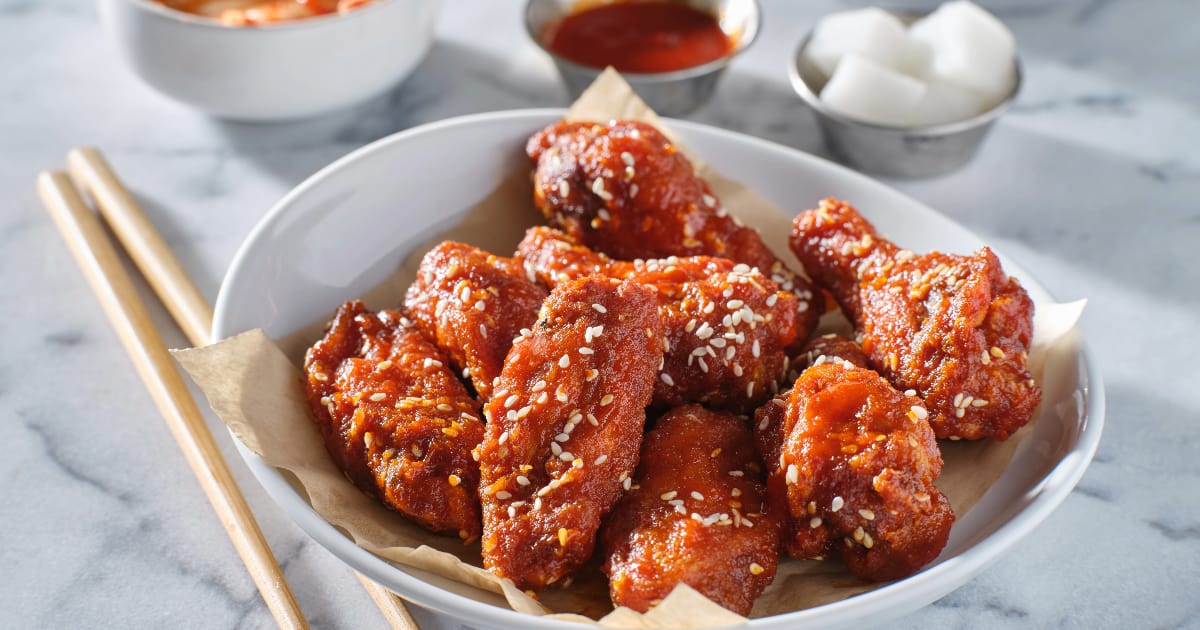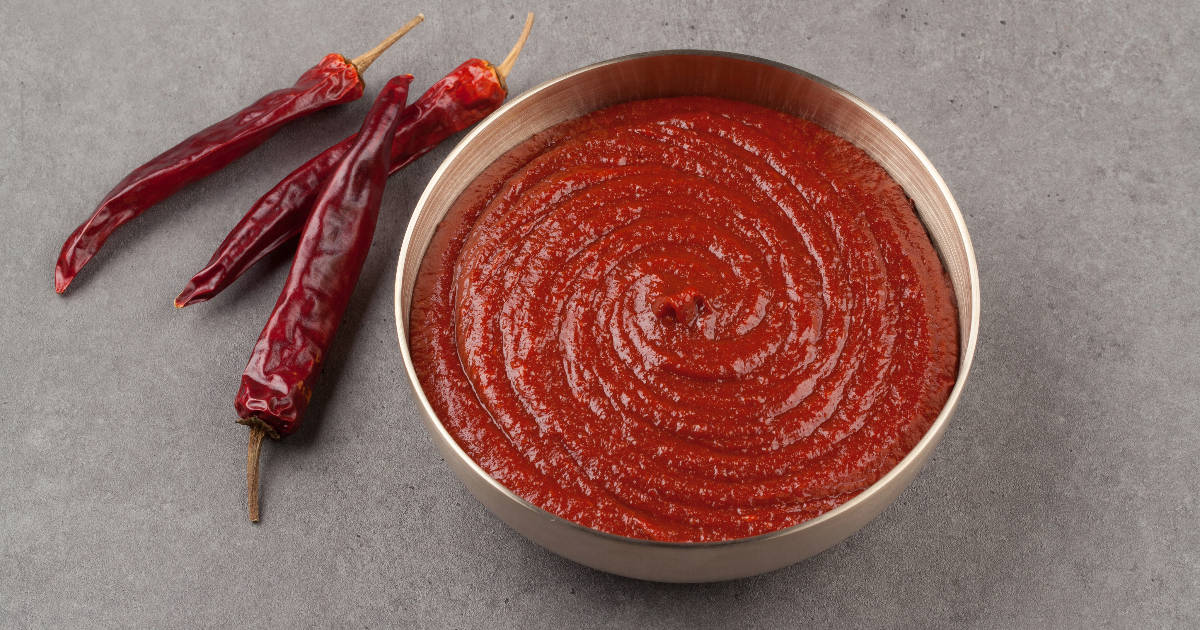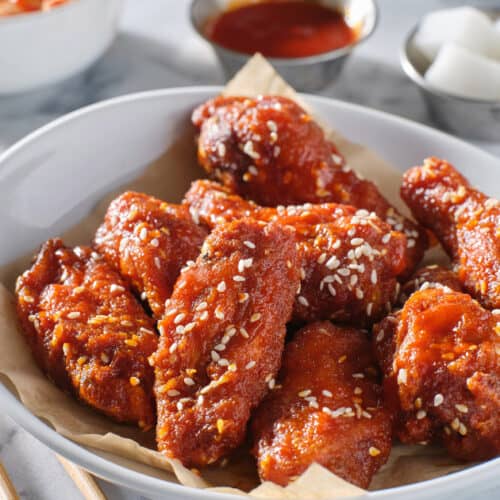Gochujang chicken is a popular Korean-inspired chicken dish that features gochujang, a sweet and spicy fermented red chili paste, as the star ingredient. This sauce lends an irresistible balance of savory, sweet, and spicy flavors to crispy fried chicken or juicy grilled or baked chicken.

Gochujang chicken can be made easily at home with just a handful of ingredients. It comes together quickly and satisfies cravings for something boldly flavored and a little sticky. This cuisine also happens to be delicious, budget-friendly, and pretty healthy when made at home.
All About Gochujang

Gochujang is a thick, sticky condiment made from fermented soybeans, glutinous rice, salt, and chili pepper powder. It supplies a savory, slightly sweet edge with a slow burn from the chilies.
This versatile Korean staple can be used to season everything from chicken to beef and seafood as well as dressings, dips, stews, and more. It's sold in tubs at Asian grocery stores and well-stocked supermarkets.
When shopping, look for gochujang made without MSG, corn syrup, or food coloring. The spiciness can range from mild to very hot depending on the amount of chili powder, so taste a little if you are spice-sensitive. Once opened, it will keep for a year in the fridge.
If you can't find gochujang, you can make a quick substitute by combining miso paste, sriracha, and a little sugar. You'll get close to the right balance of sweet, heat, and umami flavor.
Gochujang Chicken Marinade and Sauce
An easy gochujang sauce or marinade for chicken requires just a few supporting ingredients beyond the chili paste itself. Here are some common additions:
- Soy sauce - for saltiness and savory depth
- Sesame oil - for nutty aroma
- Rice vinegar - for tanginess
- Honey or brown sugar - for balancing sweetness
- Ginger and garlic - for zing and aroma
- Toasted sesame seeds - for crunch and richness
Whisk the gochujang together with any of these ingredients, along with a splash of water to thin it out. You'll end up with a smooth, glossy marinade or sauce coating for crispy, saucy Korean chicken.
Tenderizing the Chicken
For fork-tender gochujang chicken, most recipes call for boneless chicken thighs. The thin skin crisps up nicely and the dark meat stays juicy when cooked.
However, you can certainly use chicken breasts if you prefer. Just pound them thin so they cook fast and tenderize fully. Chicken tenders would also work well.
Let the chicken marinate for at least 30 minutes and up to overnight. This allows the sauce to penetrate the meat for complete flavor infusion.
Cooking Methods for Gochujang Chicken
There are several easy cooking methods to try for gochujang chicken. Each technique yields its own texture while bathing the meat in the sweet-spicy sauce.
Pan-Fried
Pan-fry chicken thighs or tenders in a bit of oil over medium-high heat until browned and cooked through, 5-8 minutes per side. Toss with the prepared gochujang sauce to coat.
Baked
For baked gochujang, coat chicken pieces with sauce and bake at 400°F on a parchment-lined sheet pan until cooked through and caramelized about 30 minutes.
Grilled
Grilling imparts delicious char. Grill over medium heat for 6-10 minutes per side depending on thickness. Glaze chicken with sauce in the last few minutes.
Air Fried
Air fryers yield crunchy exteriors. Cook battered chicken at 400°F, turning once, until cooked through, 8-12 minutes. Toss in sauce to coat.
Instant Pot
An Instant Pot lets you dump everything in at once for easy one-pot cooking. Cook thighs for 5-8 minutes at high pressure then release pressure and toss with sauce.
Slow Cooker
For slow cooker gochujang chicken, mix sauce and chicken in the insert. Cook on low for 4 hours or high for 3 until tender.
Serving Suggestions
Gochujang chicken is commonly served with:
- Steamed white or brown rice
- Fresh vegetables like snap peas and broccoli
- Kimchi
- Leafy greens
- Lettuce wraps instead of rice for low-carb
- Toasted sesame seeds and green onions
Enjoy this saucy chicken and rice bowl with an ice-cold Korean beer like Cass Lemon Ale for a refreshing pairing.
For vegetarians, try making gochujang tofu or cauliflower instead of chicken. The sauce is so flavorful that it will still satisfy.
Storage Tips
Leftovers will be kept in the refrigerator for up to 4 days. Reheat in the microwave or on the stovetop over medium heat with a splash of water to loosen the sauce.
For longer storage, gochujang chicken freezes well for 2-3 months. Let cool fully before transferring to freezer bags or airtight containers.
The gochujang sauce on its own can be made ahead too. Store it in the fridge for up to a week until ready to marinate chicken.
FAQs
How long does Gochujang last after opening?
An opened tub of gochujang will keep for up to one year in the refrigerator.
Can I sub sriracha for gochujang?
Sriracha makes an okay substitute but the flavor won't be as complex. Mix it with miso and sugar to better approximate the sweet-spicy umami of gochujang.
What does gochujang taste like?
This Korean condiment features a complex profile - sweet yet funky, salty, and spicy all at once. It has a thick, sticky texture.
Is Gochujang spicy?
Gochujang offers a slow, lingering heat. Spiciness varies greatly by brand, from mild to very hot depending on the amount of chili powder added. Check the label for guidance.
Conclusion
Gochujang chicken offers an addictively tasty twist on a weekday staple. This Korean sauce infuses chicken with the perfect savory-spicy-sweet balance. Best of all, gochujang chicken comes together easily with just a few minutes of prep time.
Serve this saucy, sticky chicken alongside steamed rice and vegetables for a fast weeknight dinner. Or present it as an appetizer at your next game day gathering or potluck. Leftovers also pack well for hassle-free lunches on the go.

Gochujang Chicken Recipe
Ingredients
- 1 lb boneless skinless chicken thighs
- 1/3 cup gochujang (Korean chili paste)
- 3 Tbsp soy sauce
- 1 Tbsp toasted sesame oil
- 2 tsp minced garlic
- 2 Tbsp brown sugar
- 2 Tbsp rice vinegar
- 1 Tbsp grated peeled ginger
- 1 tsp sesame seeds - optional garnish
- 2 green onions thinly sliced - optional garnish
Instructions
- If using chicken breasts, pound them to 1⁄2-inch thickness so they cook quickly and tenderize fully. Cut chicken into bite-sized pieces. Place in a bowl or plastic bag.
- In a small bowl, whisk together the gochujang, soy sauce, sesame oil, garlic, brown sugar, rice vinegar, and ginger. Pour over the chicken. Toss to coat.
- Cover and marinate for at least 30 minutes, up to overnight.
- Cook using one of the following methods:
- Pan-fry: Heat 1 Tbsp oil in a skillet over medium-high heat. Add chicken and cook 5-8 minutes per side until browned and cooked through. Toss with sauce from marinade bowl to coat.
- Bake: Place chicken on a parchment-lined baking sheet. Bake at 400°F for 25-30 minutes until cooked through and caramelized on edges. Toss with sauce to coat.
- Grill: Grill chicken over medium heat for 6-10 minutes per side depending on thickness. During last 2 minutes, brush with reserved marinade sauce to glaze.
- Air Fry: Cook battered chicken at 400°F for 8-12 minutes, flipping halfway, until cooked through and crispy. Toss in sauce to coat.
- Instant Pot: Combine chicken and marinade in pot. Cook at high pressure for 5-8 minutes then quick or natural release. Shred chicken and toss with sauce.
- Slow Cooker: Place chicken and marinade in cooker. Cook on low for 4 hours or high for 3 hours until chicken is very tender.
- Garnish with sesame seeds and green onions if desired. Enjoy with rice and vegetables.

